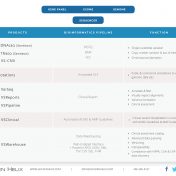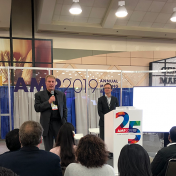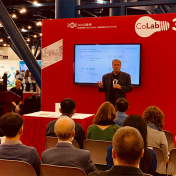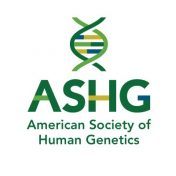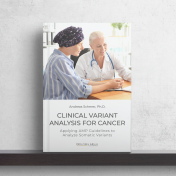We are incredibly grateful to be recognized as one of the Top 60 Genetics Blogs on the Web by Feedspot. Our team is dedicated to educating our readers on how our solutions can help enable precision medicine, and we are so honored to have received this recognition. On our blog, you will discover posts touching on important topics, like cyber security strategies,… Read more »
We’re packing our bags and getting ready to head out to San Diego, CA for the International Plant & Animal Genome XXVIII meeting (or PAG 2020). This is the largest ag-genomics meeting in the world, bringing together over 3,000 leading genetic scientists and researchers in plant and animal research, and over 120 exhibits, 140+ workshops, 1000+ posters, and 1700+ abstracts. We… Read more »
Happy New Year! Certainly, I hope you had a relaxing time over the holidays with family and friends as well as a great start into the new year. 2019 was a real landmark year for Golden Helix. Please let me mention a few highlights: Now, for 2020 we will plan to continue to build on this success. Here are some… Read more »
As clinical genetic tests have been adopted as a critical enabler of precision medicine, the number of tests offered by clinical labs and the volume of tested patients has grown by orders of magnitude in the past five years. The Gene Testing Registry, managed by the NIH, documented a rise from 13,000 to 60,000 tests offered in the US market… Read more »
November is the month where we pause to reflect on what we are thankful for. At Golden Helix, we are thankful for the many dedicated scientists and practitioners who are tirelessly working on new discoveries to enhance the lives of humans and preserve our food supply in the face of ever-changing conditions in agriculture. As always, we are proud to… Read more »
Our team has returned from the annual meeting of the Association of Molecular Pathology (AMP 2019), and, as always, I am grateful for all the wonderful experiences we are bringing back with us. The plenary sessions and talks were bountiful, and we were very impressed with the well-organized exhibition. Hats off to everyone involved in planning this great event! Innovation… Read more »
We have recently added a tutorial to help introduce customers to the ease and utility of the AMP Guidelines incorporated in VarSeq’s VSClinical package. The AMP Guidelines allow users to sort through available clinical evidence in a streamlined fashion to arrive at final classification and interpretation and then transfer that information into a clinical report. And the AMP Guidelines also… Read more »
With October being recognized as Breast Cancer Awareness Month, the team at Golden Helix thought it would be appropriate to pay tribute to some of the publications that over the years, have contributed to the many discoveries made in breast cancer diagnosis, prediction, underlying causes, and case management. We are very proud to be a part of cancer research and… Read more »
VarSeq 2.2.0 was released today and this a stable release full of upgrades and polishes. Some of the newer features include the ability to store and include AMP Cancer assessment catalogs on VSWarehouse, quicker accessibility to common annotations plotted in GenomeBrowse, and the addition of all of our standard templates for the GRCh38 genome assembly. Many of the polishes were… Read more »
As our team returns from another successful ASHG conference, I would like to reflect on the great memories, connections, and future plans that were made at this meeting. First, I will start by thanking everyone involved with the superb planning and execution of the conference. We are thankful to have this opportunity to connect with our customers, partners, and friends… Read more »
Our team is getting ready to head to Houston, Texas for the American Society of Human Genetics Annual Meeting (ASHG) 2019. We are looking forward to spending the week discussing genetics with new and familiar faces! If you are planning on attending, please stop by our booth and say hello! You will find the Golden Helix team in booth 601…. Read more »
The common approaches to detecting copy number variants (CNVs) are chromosomal microarray and MLPA. However, both options increase analysis time, per sample costs, and are limited to the size of CNV events that can be detected. VarSeq’s CNV caller, on the other hand, allows users to detect CNVs from the coverage profile stored in the BAM file, which allows you… Read more »
From diagnosing, treating and preventing diseases in humans and animals, to preserving our global food supply, Golden Helix products are being used all over the world! In September, we were cited in many publications spanning a diverse range of species and topics. Below are brief recaps of a few of the studies where SNP & Variation Suite (SVS) and VarSeq… Read more »
Gene Fusion Background Gene fusions are hybrid genes that result from translocations, interstitial deletions, or chromosomal inversions that can lead to constitutive gene activation and result in increased or abnormal protein production. Increased or abnormal protein production subsequently can play an important role in tumorigenesis and thus identifying and evaluating this type of biomarker is important in the cancer workspace…. Read more »
VSClinical users can interpret and report genomic mutations in cancer following the AMP guidelines which we’re demonstrating in this “Following the AMP Guidelines with VSClinical” blog series. Part I introduced the hands-on analysis steps involved in creating a high-quality clinical report for targeted Next-Generation Sequencing (NGS) assays. We reviewed sample and variant quality, including the depth of coverage over the target regions by the sequencing performed for each sample. Now, we are ready to… Read more »
We are always excited to see how our software is used to support research and enable precision medicine. We believe that our customer’s success is ultimately our success! This summer was filled with many wonderful publications from across the globe and we are proud to have been a part of them. Here are just a few from each month: June… Read more »
In the world of genomics shaping precision medicine in oncology, the limiting factor is the time-to-sign-out of a fully interpreted molecular profile report. There are many components of the entire testing process that add to the turn-around time of each test. Many of these steps, such as sample prep, sequencing, and automated secondary analysis, are bounded and consistent in their time requirements. The hands-on… Read more »
With the increasing knowledge of mutations involved in cancer, it is imperative to have a tertiary analysis pipeline that provides users with the most up to date information on somatic mutations. VSClinical’s Cancer Add-On does just that and more; with this feature, users can investigate and report on SNVs, indels, CNVs, gene fusions, and considerations for wild type genes in… Read more »
Clinical Variant Analysis for Cancer – Applying AMP Guidelines to Analyze Somatic Variants Detecting cancer at an early stage can make it much more treatable. Developing tests and making them clinically actionable is crucial to beat this disease. This eBook covers the state-of-the-art gene panel tests for cancer. Of course, there is more that can be done. The field is… Read more »
Clinical Variant Analysis for Cancer – Applying AMP Guidelines to Analyze Somatic Variants As described in my eBook “Genetic Testing for Cancer,” any bioinformatic pipeline for cancer ultimately calls variants based on the aligned reads that the sequencer generated. Variant calling is the process of reviewing a sequence alignment, typically in the form of a BAM file, to identify loci… Read more »


